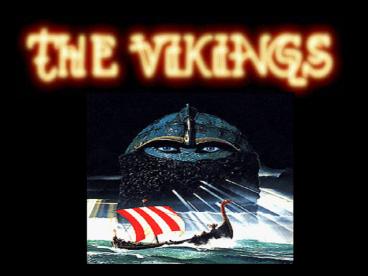Presentation Plus! - PowerPoint PPT Presentation
1 / 16
Title:
Presentation Plus!
Description:
... married children, and grandchildren. The People Viking warriors were called berserkers. They fought to ... the people became known as Normans. The Danes ... – PowerPoint PPT presentation
Number of Views:49
Avg rating:3.0/5.0
Title: Presentation Plus!
1
(No Transcript)
2
SECTION 1 The Land SECTION 2 Daily
Life SECTION 3 Raiders and Adventurers
3
Terms to Learn
People to Know (cont.)
- Leif Eriksson
- jarls
- berserkers
- Eddas
- runes
- Canute
- Rollo
Places to Locate
People to Know
- Scandinavia
- Rurik
- Jutland
- Vinland
- Norselaw
- Erik the Red
4
The Land
- Scandinavia, the Viking homeland, was mostly
forests and long, rugged coastlines.
- The southern part, known as Jutland, or Denmark,
had many natural harbors and was well suited for
farming grains and pasturing cattle, sheep, and
pigs. - As the rest of Scandinavia had rocky soil, a
short growing season, and many fjords, or narrow
bays, the people turned to the sea to make a
living.
5
Ships and Trade
- The Vikings built large, long, and narrow ships
with timber from the dense forests.
- The Vikings plotted their search of good fishing
areas and trade by the positions of the sun and
the stars. - They carried furs, hides, fish, and enslaved
people to western Europe and the Mediterranean
they returned with silk, wine, wheat, and silver.
6
Towns, Villages, and Jarls
- Trade led to the growth of market towns in
Scandinavia.
- Most Vikings lived in log or board houses in
villages scattered all through the country. - There was no central government as distance and
cold winters isolated the villages. - The people were divided into groups ruled by
elected or inherited military chiefs called
jarls. - When a jarl had enough land under his rule, he
was looked upon as a king.
7
Daily Life
- Vikings valued family life, and most households
had 20 to 30 members, including parents,
grandparents, married children, and
grandchildren.
8
The People
- Viking warriors were called berserkers.
- They fought to gain wealth, honor, and fame,
believing that a liking for war brought special
honors from the gods. - To call their warriors to battle, the Vikings lit
bonfires on mountaintops. - The women encouraged their men to fight, took
complete charge of the home, and could own
property and get a divorce. - The Vikings had no schools.
9
Religion
- The Vikings worshiped many gods at first that
were similar to the Germanic gods, and then they
changed their gods to suit the hard life of
Scandinavia.
- The Vikings offered sacrifices and prayed to
their gods to get what they wanted. - The Vikings told proud stories of the gods' great
deeds that later became written poems called
Eddas. - Over time, the Vikings language developed into
fourDanish, Norwegian, Swedish, and Icelandic.
10
Religion (cont.)
- These languages were written with letters called
runes, which few people except priests could
understand or use.
- When the Vikings accepted Christianity, they
began to write their languages with Roman
letters.
11
Raiders and Adventurers
- By the end of the 800s, many Viking villages were
overcrowded, food was in short supply, there was
no central government, and the kings constantly
fought one another.
- Viking warriors began to set sail to seek their
fortunes in other lands.
12
From East Europe to North America
- Viking adventurers traveled to and raided areas
from east Europe to North America.
- Swedish Vikings crossed the Baltic Sea and
traveled down the rivers toward what is now
Belarus, Ukraine, and Russia. - In 862, a Swedish chief named Rurik founded a
Viking settlement that became the Kievan Rus
state. - Norwegian Vikings set up trading towns in
Ireland, explored the North Atlantic, and founded
a colony on Iceland.
13
From East Europe to North America (cont.)
- Led by Erik the Red, they founded a colony on the
island of Greenland in 986.
- Eriks son, Leif Eriksson, landed on the
northeast coast of North America and named the
spot Vinland because of the wild grapes growing
there. - Viking adventurers went to western and southern
Europe in search of food and valuables.
14
From East Europe to North America (cont.)
- Because they stole, destroyed homes, burned
churches, and killed or enslaved people, all of
Europe feared the Vikings.
15
The Danes
- The Danes were among those Vikings who raided
western and southern Europe.
- In 1016, a powerful Danish king called Knut, or
Canute, conquered England and made it part of his
North Sea Empire. - Led by a warrior named Rollo, the Danes began
settling along the French coast opposite England.
- In 911, the French king signed a treaty with
Rollo to give the Danes this land.
16
The Danes (cont.)
- The region in which the Danes settled became
known first as the Norselaw and then as Normandy
the people became known as Normans.































